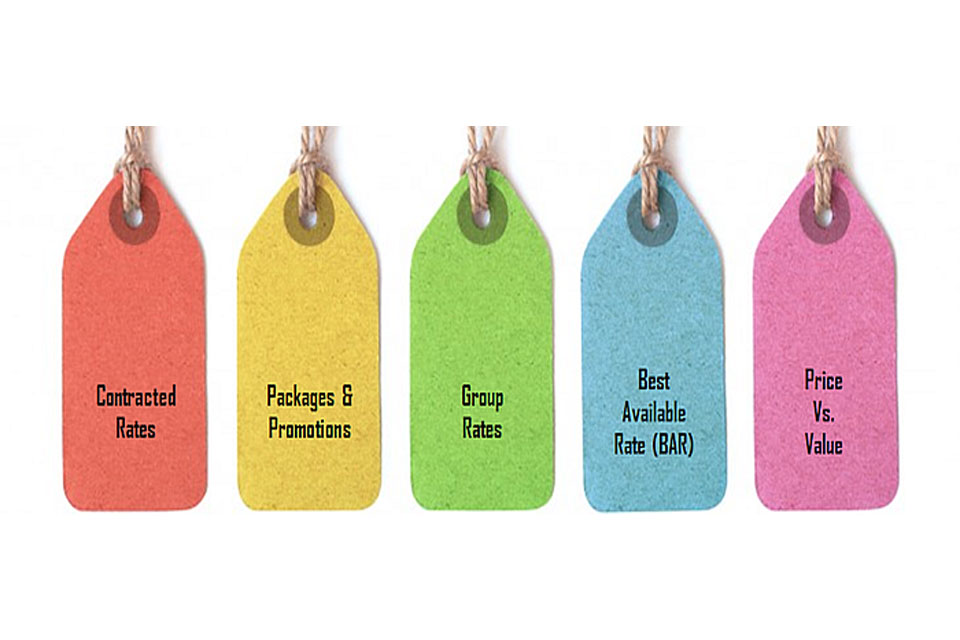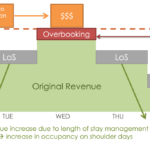Blog

The key to profitability begins with the right pricing. While Revenue Management is the holy-grail, having the right pricing strategy can be an effective means to optimize your business. However, as with most of the things the ‘strategy’ comes before the ‘tactics’. Therefore, before we delve into how to actually set the pricing, it is important to understand the Pricing Structure.
What is a Price Structure?
A pricing structure, also called a rate structure, is made up of all the rates you could potentially offer a customer. This varies for every hotel based on the market segments served by the hotel. Pricing at the transaction level is managed in most hotels using a pricing structure.
Approach
MARKET SEGMENTATION
The right pricing structure takes into consideration multiple factors but the key foundation is Market Segmentation. Once you understand your business mix and your product positioning, pricing strategy for corresponding market segments can be set. It is important to note that one must not only evaluate past business KPIs for each market segment but also identify new segments and further analyse which of these market segments it wants to promote or discourage.
Sometimes, a hotel may be too dependent on a particular market segment that may be detrimental to its profitability. It is always a good idea to create a healthy business mix. This also allows you to hedge your risks. Once you have defined market segmentation for your hotel, your pricing structure will often mirror or follow the structure of the segmentation that you have created for your hotel.
DECIDING ON PRICE HIERARCHY
The next consideration is for you to decide what pricing mechanism (sometimes referred to a Rate Plan) works best for which segments. You will need to define pricing for your Transient & Group segments.
TRANSIENT SEGMENT:
For Transient segment, you need to consider if you would apply Fixed Rates and/or Dynamic Pricing, You will also need to keep in mind the concept of Qualified and Unqualified pricing.
Qualified: These are specific rates that a customer can obtain by qualifying to certain criterion like volume base within in a specific period, lead time, length of stay, non-refundable rates, full deposit required, etc. For example, “Book 7 days in advance to avail 15% off on the Best Available Rate” is commonly referred to as an Early Bird Offer is a Qualified Rate. A Corporate rate with a specific negotiated price for a specific period for a volume business is another example of a Qualified Rate.
Unqualified: These rates are widely referred to as Best Available Rate or Best Flexible Rate or Best Guaranteed Rate which does not have any rate fencing and unconditional.
Fixed Rates: as the name implies are rates that are generally not altered except under certain conditions. Often they are known as Negotiated rates or Contracted rates and may have an applicable time frame for a specific volume of business. Such rates may also be applied to a certain section of guests.
Dynamic Rates: allows you to offer different prices to customers based on the search criteria, length of stay, day of arrival etc. driven by pricing transparency. Dynamic Pricing allows you to have multiple price points thereby offering a mechanism for you to adjust your prices to respond to market volatility (cost, supply, demand, and competition), thereby maximizing your profits. It also creates an opportunity to levy equal pricing for all customers at any given time. Read more about why Dynamic Pricing is an important factor for pricing in hotels.
Best Available Rates (BAR): Best Available Rate is defined as the optimal rate to quote based on the probability of booking the guest. While effective, Best Available Rate requires the correct balance between demand and price. BAR rate is the recommended rate for customers who don’t have a pre-contracted rate, and are not qualified for any discounts.
GROUP SEGMENTS
Group Rates: are negotiated / contracted rates that are offered to customers who stay in groups for a purpose of Business or Leisure or Social Events for a certain volume guarantee and usually for a specific period.
Group rates are often bundled with packages, conference facilities etc., and is generally based on the detailed understanding of overall requirements of customers. It is important to protect a certain level of room yield from group rate and create layers in terms of other packages and attributes; this helps you base even group rates on the cost vs benefits on the other attributes that may be bundled with the room rates.
Other considerations that affect group rates include factors such as if the business is for an ad-hoc or series and whether there is a venue / meeting space involved along with the rooms. Having a carefully considered price structure that is layered for such combinations lays out a clear structure for sales teams to quote and to win business. These group rates are further used to understand and calculate the displacement cost of the business on any specific period before confirming any rates to the groups.
DIGGING DEEPER:
Whether you choose Fixed Rates or Dynamic Pricing, each has its own merits and demands a closer look. Most hotels will have to have a pricing structure that can handle both a fixed and dynamic pricing. Tie your pricing back into your segmentation – do they match and is everything accounted for? One does not exclude the other – a mix of the different pricing models is the best option for most hotels and situations.
FIXED RATES THE PANACEA FOR GUARANTEED BUSINESS?
When considering Fixed Rates, sometimes, what seems at first to be an obvious logic to enter into fixed rate contracts is not so sensible when you look at it beneath the surface.
For instance, often companies are offered negotiated corporate rates based on the Volume of business (Company Volume Guaranteed Rate or CVGR). For the coming year, you may offer a better rate to a Company A that gives higher volume than Company B who used fewer rooms in the same period. But what if the Company A’s higher volume happened on your Peak days and the rest of the year the production from this company was in fact fairly small? Whereas, Company B’s production was low but consistent all year. In that case, would you still believe that Company A should get the better rate?
It may also be the case that Company A only comes on your peak days, that might be because they already have a competitor hotel lined up who they go to before they come to you. In other words, they come to you when they can’t get rooms elsewhere. If they only come to you on your peak days when you could have sold your rooms at a higher rate to other customers then the true value of Company A to your business needs to be re-evaluated.
DYNAMIC PRICING – AS SIMPLE AS IT SEEMS?
There is an increasing customer acceptance of Dynamic Pricing. The Airlines industry has conditioned the guests to accept this pricing method as a fair approach.
While Dynamic Pricing seems a good choice, to be effective, it requires structured processes and standards, consistency and a thorough understanding of the ‘Why’s and ‘Who’s.
Defining the various levels of BAR itself has to be done carefully to be able to leverage the benefits that are associated with this mechanism. But having one BAR may not be right approach to capture all the value your market is willing to spend on you. For this reason, many hotels have started to make use of the Best Available Rates as basis to derive other rates using the Derivative BAR rates – Rates that are linked on the BAR for that particular day. So any change to the Best Available Rate affects these rates too.
For example a discounted rate based on a 7-day advance booking with a certain percentage discount on the BAR. Obviously this practice means that you need to be extremely careful in how you select the base BAR for the day.
Putting it all together:
After you have carefully considered your Market Segmentation and the value perceptions of your customers, you need to begin the process of actually putting together all your pricing plans and rates in a single comprehensible document. This pricing document should have a clear demarcation of the various rate plans that are being offered to the various segments. Careful consideration should be done to set the pricing so as to avoid encroachment of one segment by another. This becomes the hotel’s guiding light for any rate decisions.
So what do we gain from all this?
Closely coupling your pricing structure to the market segmentation helps you encourage the continued development of each segment. The Price structure can be a great tool to ‘promote’ market segments that are more beneficial (productive / high-yield) for your hotel than others. Similarly you can have a more restrictive or stringent pricing plan for segments that are low yielding (and you want to ‘wean away’ from). This helps you gradually achieve the ideal business mix for your hotel.
Structured Pricing helps you not only price your market segments independently but also prevents one segment from eating into the other or ‘cannibalization’.
The pricing structure will also help you plan and forecast the ARR for each micro segment and help you arrive at the projected Average Daily Rate for the Hotel. This is a great help when you do a budgeting exercise.
Overall having a Structured Pricing approach helps you maximize the business from each segment and brings in better clarity for your reservations and sales team to go out and win business with confidence.
Subscribe & Follow
Recent Tweets
Recent Posts
-

Unlocking Profitability Through Revolutionary Revenue Management: A…
December 15, 2023 -

Why is it important to segment your…
November 30, 2023 -

Full pattern Length of Stay controls increase…
September 26, 2023 -

Achieving the Right Mix of Strategic &…
January 11, 2019 -

Better Budgeting Through Revenue Management
December 21, 2018
Facebook Posts
getRevOpt
Go beyond organic to Expenential Growth
BRING IN THE EXPERTSWhat makes Revopt Unique?
Our unparalleled services helps hotels, chains and management companies develop collective
knowledge of revenue management and upskill their teams to drive exponential revenue.
-
Exponential Revenue
GrowthRevOpt helps you to go beyond organic to Exponential Growth by unlocking the true revenue potential to achieve optimal performance.
-
Automated Revenue
Management SystemCustom tailored to your exact needs. Increased revenues 6%-18%. Multiply profits in as little as 15 minutes per day. Outperform competitiors by 36% or more.
-
Long-term Profitability
& Asset ValueTailor made revenue optimization solution to create a sustainable growth strategy to increase profitability & long-term asset value.
-
Expertise with
unparallelled ServicesRevOpt best industry practices, proven techniques, latest trends & strategies that help hotels to challenge the status quo & outperform the competitors.
